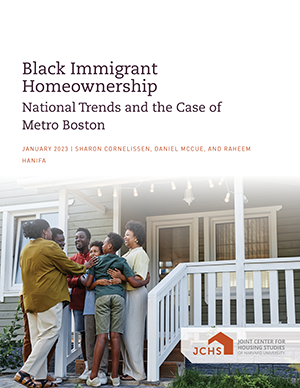Black Immigrant Homeownership: National Trends and the Case of Metro Boston
Persistent racial and ethnic gaps in homeownership rates have recently led policy makers to create a range of programs and initiatives to expand and maintain Black homeownership. These include developing special-purpose credit programs targeted at Black and Hispanic buyers, issuing more small-dollar mortgages below $100,000 to finance lower-valued property, and innovating credit score models. These efforts must account for the fact that Black homeowners live in a broad range of locales and circumstances. Indeed, the demographic composition of Black households has changed over the past few decades. In 2019 nearly one in eight households headed by a Black person in the US (12%) was headed by someone born in another country, having migrated from countries including Jamaica, Haiti, Nigeria, Ethiopia, Ghana, Trinidad & Tobago, the Dominican Republic, and Cape Verde. As of 2019, 2.0 million households were headed by a Black immigrant in the United States.
This paper begins by highlighting national trends in Black immigration and homeownership. We show in what states and regions Black immigrants live and have become homeowners across the nation. We also examine what helps explain the unequal success of different Black immigrant groups at attaining homeownership, considering differences by county of origin, age structures, and immigration histories. Second, we take the case of Massachusetts and analyze how Black immigrant homeownership has changed in suburban communities and cities outside of Boston over the last decade as well as within the city itself. Metropolitan Boston offers an important case study of the homeownership trajectories of Black immigrants. In our conclusion, we link our findings back to policy initiatives to mitigate the racial homeownership gap. We argue that as Black households have become increasingly diverse over the last few decades, any focus on Black homeownership can benefit from considering Black immigrants, too. This is particularly true in states such as New York, Florida, Texas, and Massachusetts, which house some of the nation’s largest Black immigrant populations. We conclude by offering specific policy recommendations aimed at supporting Black immigrant homeownership, tailored to both distinct challenges and opportunities.

